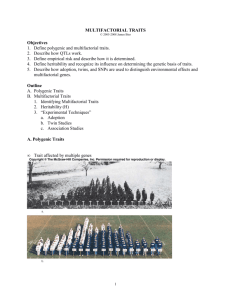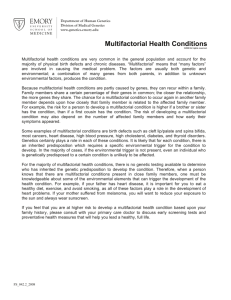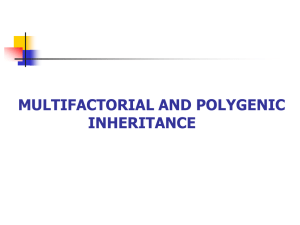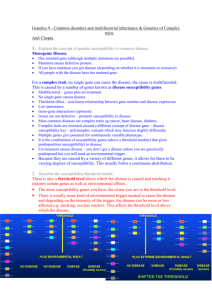multifactorial inheritence_4
advertisement
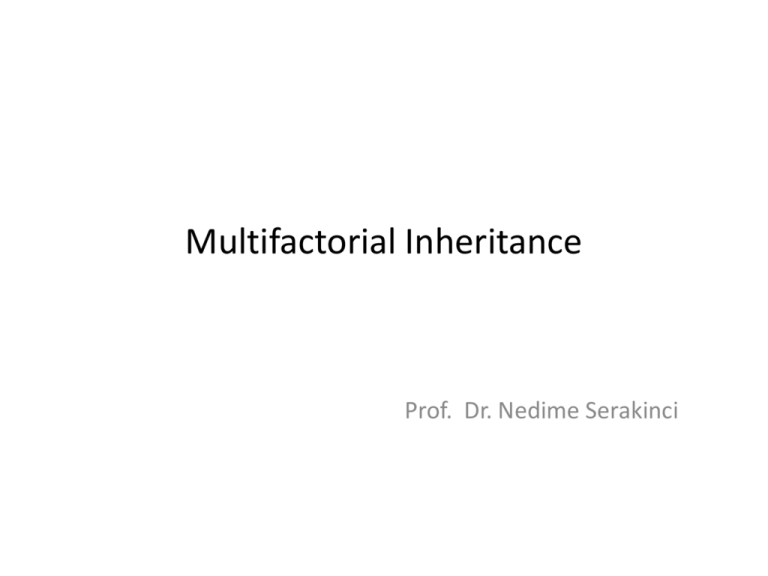
Multifactorial Inheritance
Prof. Dr. Nedime Serakinci
GENETICS
• I. Importance of genetics. Genetic terminology.
• I. Mendelian Genetics, Mendel’s Laws (Law of Segregation, Law of
Independent Assortment). Generations, crosses, etc.
• In humans, modes of inheritance (AR, AD, X-linked inheritance).
• II. Extensions to Mendelism; variable expressivity, incomplete
penetrance, incomplete dominancy, codominancy, genetic
heterogeneity, pleiotropy, environmental influences, sporadic cases,
etc.
• IV. Non-Mendelian inheritance; maternal inheritance, genomic
imprinting, X-inactivation, polygenetic inheritance, genetic
susceptibility
Non Mendelian Genetics
• Characters Mendel studied in peas almost
simple and straight-forward.
• The relationship between genotype and
phenotype may be more complex in many
traits.
– Multifactorial disorders
– Sometic cell genetic disorders
– Mitocondrial disorders
MULTIFACTORIAL INHERITANCE
• Multi-”FACTORIAL”, not just multi-GENIC
• Common phenotypic expressions governed by
“multifactorial” inheritance
– Hair color
– Eye color
– Skin color
– Height
– Intelligence
– Diabetes, type II
If the son's height were completely determined by the father's height,
the correlation would be as shown by the solid blue line. What is
observed is shown by the dashed red line. The height of the father and
the average height of the son are related, but the average height of the
son always regresses toward the mean. That is understandable if there
is no dominance. The son only gets half of his father's genes; the other
half comes from his mother
FEATURES of multifactorial inheritance
• Expression determined by NUMBER of genes
• Overall 5% chance of 1st degree relatives having it
• Identical twins >>>5%, but WAY less than 100%
• This 5% is increased if more children have it
• Expression of CONTINUOUS traits (e.g., height)
vs. DISCONTINUOUS traits (e.g., diabetes)
If a disease or condition is
scalable, rather than on or off,
it is probably multigenic, or
multifactorial, just part of the
spectrum of HOMO-zygous
diseases being HOMOgeneous, and HETERO-zygous
diseases being VARIABLE.
Human characteristics that show a continuous
normal distribution, and are therefore
multifactorial.
Blood pressure
Dermatoglyphics (ridge count)
Head circumference
Height
Intelligence
Skin color
Heart disease
Many more.....................
Multifactorial disorders
• Result of both environmental and genetic factors.
• Relative importance of genetic factors is variable.
• Familial tendency apparent but do not follow the
characteristic pedigree patterns of single-gene
disorders.
• Numerous genetic alterations may predispose
individuals to the same disease
Multifactorial disorders - examples
Diseases of childhood and adult life
• Neural tube defects
• Asthma
• Diabetes mellitus
• Hypertension
• Coronary heart disease
• Cancer
• Epilepsy
• Manic depression
• Rheumatoid arthritis
• Alzheimer’s Disease
Polygenic and multifactorial inheritance
• Many disorders demonstrate familial clustering that does not
conform to any recognized pattern of Mendelian inheritance.
Examples include several of the most common congenital
malformations and many of the common acquired diseases of
childhood and adult life.
• It is likely that many factors – genetic and environmental – are
involved in causing these disorders that are showing multiple gene
inheritance – the two types being multifactorial and polygenic.
• Multifactorial conditions show normal distribution, and are
generated by many genes. Polygenic conditions show a liability
threshold, where genes act in an additive, but discontinuous
fashion.
Consider the following: One locus for height, with three alleles.
Allele h2 adds 2 inches to the average 68-inch height. Allele h0 neither
adds nor subtracts from the average height of 68 inches. And allele hsubtracts 2 inches from the average height. Suppose h0 is twice as
frequent as either h2 or h-. The Punnett square for the population
would be as follows:
If a second locus, called the tall locus, or t, is also involved in height,
with three alleles as above, one adding two inches, one neither
adding nor subtracting from the phenotype, and one subtracting 2
inches, with the neutral allele occurring twice as frequently as the
either of the others
THE MULTIFACTORIAL MODEL
• As more loci are included, this binomial
distribution quickly approaches the Gaussian
distribution, or the bell-shaped normal curve,
observed with human quantitative traits.
Three loci, each with three alleles, are enough
to produce population frequencies
indistinguishable from a normal curve.
The multifactorial model is then:
Several, but not an unlimited number, loci are involved in the
expression of the trait.
There is no dominance or recessivity at each of these loci.
The loci act in concert in an additive fashion, each adding or
detracting a small amount from the phenotype.
The environment interacts with the genotype to produce the final
phenotype.
As an example of 4. above, women are, on average, three inches
shorter than men with the same genome. Environmental factors
(hormones) affect the final phenotype.
Not all human traits that show a continuous distribution in the
population are multifactorial traits.
Any bimodal distribution is not controlled by multifactorial
expression. It is more likely to be under the control of a single
dominant/recessive gene with modifying environmental factors.
Multifactorial traits all show a unimodal bell-shaped distribution.
MULTIFACTORIAL INHERITANCE
•
What is known as multifactorial or quantitative inheritance?
This involves the inheritance and expression of a phenotype being determined by many
genes at different loci and each gene exerting a small additive effect, in a continuous
distribution mode.
Effects of the genes are cumulative , with each gene contributing a small amount to the
final expressed phenotype. No one gene is dominant or recessive to another.
Several human characteristics show a continuous distribution in the population that closely
resembles a normal distribution.
Approximately 68%, 95% and 99.7% of observations fall within the mean plus or minus one,
two or three standard deviations respectively.
Multifactorial trait
• Complex ( conditions caused by many contributing
factors are called complex or multi factorial, partly
genetic
• Common medical probems, Either distinct
(discontinous, e.g. disease like heart disease,
Coronary artery disease (CAD), Diabetes Mellutus
(DM), Alzheimer) or continous phenotypes (e.g.
height, blood pressure level)
Multifactorial trait
• Discontinous traits – risk to relatives of
affected individual > population risk
• Rapidly falls in distant relatives
• Pedigree analysis is not very useful as in
Mendelian disorders
Continous traits
• e.g. Physical
characterstics like
height, weight, red
cell size, hemoglobin
level etc..
• Usually show
Gaussian
distribution
height - polygenic (additive) inheritance
Polygenic Traits are quantitative rather than
qualitative in nature. They are frequently
distributed continuously in the population,
often in a more or less bell shaped curve or
they may fit the threshold model. polygenic
traits include height, blood pressure, cleft lip
cleft palate, NTDs .
A frequency distribution of systolic blood
pressure determined by a two-locus two
allele model was presented
Discontinous traits
• Common adult diseases
• Balance between the
underactive and
• Congenital
malformations
normally active genes is
important
• Balance exceeds a
threshold → phenotype
DEGREE OF RELATIONSHIP AND GENES IN COMMON
Conversion of a standard
pedigree to a path coefficient
pedigree for determining the
fraction of genes in common.
I-1 and I-2. To determine the fraction of genes II-2 and II-3 have in common one simply counts all of the pathways and their
connecting lines through the common ancestors. There is one line from II-2 to I-1, and a line from I-1 to II-3. That is one
pathway with two lines of descent. There is another line from II-2 to I-2, and a line from I-2 to II-3. That is a second pathway
with two lines of descent. These are the only pathways from II-2 to II-3. The fraction 1/2 is then raised to the power of the
number of lines of descent and summed for each possible pathway, (1/2) 2 for the pathway through I-1, and (1/2)2 for the
pathway through I-2, making a total of 1/2. Brothers and sisters have, on average, 1/2 of their genes in common.
A parent and offspring, say I-1 and II-2 also have 1/2 of their genes in common. There is only one pathway between them and
only one line in that pathway, (1/2)1.
Other relationships follow in the same manner. In Figure 16, III-1 and III-3 are first cousins. There are two pathways
connecting the two individuals, one through I-1 and the other through I-2, each with four lines. Their fraction of genes in
common is then (1/2)4 + (1/2)4 or 1/8. First cousins have 1/8 of their genes in common. A grandparent and grandchild have
1/4 of their genes in common. There is a single pathway with two lines of descent. III-1 and IV-1 are first cousins once
removed. Again there are two pathways, one through I-1 and the other through I-2, each with 5 lines, (1/2)5 + (1/2)5 or 1/16
of their genes in common.
The degree of relationship is often used rather than the fraction of genes in common. The degree of relationship is simply the
power to which (1/2) is raised to reach the fraction of genes in common. First degree relatives have (1/2) of their genes in
common. Second degree relatives have 1/4, (1/2)2, of their genes in common, etc.
familial aggregation
• measured by relative risk (λr) =
disease prevalence in relatives
disease prevalence in population
• Prevalence is a measurement of all individuals affected by the
disease (at a particular time) and is expressed as a proportion
of the population
CONCORDANCE
Twin studies, although limited by complicating factors, provide the
best source for separating genetic contributions to the trait being
studied from environmental influences.
• Monozygous (identical) twins have the same genome, but not the exact
environmental factors, especially if they were raised apart.
• The concordance rate in monozygotic twins can be compared to the
concordance rate in dizygotic (fraternal) twins to estimate the genetic
component (heritability) of the trait. If the trait is truly 100% genetic, as it is for
total fingerprint ridge count in humans, monozygotic twins will be 100%
concordant while dizygotic twins, having, on average, only half their genes in
common, will have a lower concordance rate. If the trait under study is 100%
environmental, monozygotic twins and dizygotic twins will have the same
concordance rate. The concordance rate for a disease is calculated as follows:
• Concordance Rate = [Both Affected / (One Affected + Both Affected)] x 100
Twin studies
• MZ rates compared to DZ rates for specific traits
• The more similar rates, the less genetic contribution
Essential Medical Genetics, 6th edition. Tobias, Connor, Ferguson-Smith. Published 2011 by
Blackwell Published Ltd
Twin studies
• Monozygotic (MZ) or dizygotic (DZ)
• Diagnosis needs DNA marker analysis
• MZ: genetically identical
• Twins also share the environment!
Family correlation studies
• Relatives share genes
• Multifactorial traits – expressed in them according to genetic
similarity
Essential Medical Genetics, 6th edition. Tobias, Connor, Ferguson-Smith. Published 2011 by
Blackwell Published Ltd
Degrees of relationship
Relationship
Proportion of genes shared
-----------------------------------------------------------------------First degree
{1/2}
Parents, Siblings, Children
------------------------------------------------------------------------------------Second degree
{1/4}
Uncles and aunts, nephews and nieces
Grandparents, grandchildren, half-siblings
------------------------------------------------------------------------------------Third degree
{1/8}
First cousins, Great- grandparents,
Great- grandchildren
-------------------------------------------------------------------------------------
Family correlation studies
• Similarity of relatives – correlation
• 0 – 1, 1=identical
• If genetic, the closer the higher correlation
• Parents: not expected to be correlated unless blood relatives
Essential Medical Genetics, 6th edition. Tobias, Connor, Ferguson-Smith. Published 2011 by Blackwell Published Ltd
Discontinous traits - liability / threshold model
• Liability: all factors which influence
the development of a multifactorial
disorder, whether genetic or not,
• the liabilities of all individuals in the
population form a continuous
variable
• the risk is distributed normally
• the disorder occurs only when a
certain threshold is exceeded
The threshold model for multifactorial traits. Below the threshold the trait is not
expressed. Individuals above the threshold have the disease.
Liability - threshold
Liability/threshold model - summary
• Recurrence risk: biggest for the most close relatives,
decreases rapidly in more distant ones
• Incidence: biggest among relatives of most severly affected
ones
• The more affected in a family, the bigger the risk for others
• If the trait is expressed more in one sex than in the other, the
risk of recurrence is greater in the offspring if the affected
parent belongs to the less frequently affected sex
MULTIFACTORIAL inheritance.
• In reality, human characteristics such as height and intelligence are also
influenced by environment, and possibly also by genes that are not
additive in that they exert a dominant effect.
• These factors probably account for the observed tendency of offspring to
show what is known as a “regression to the mean”.
• This is demonstrated by tall or intelligent parents (the two are not
mutually exclusive!) having children whose average height or intelligence
is slightly lower than average or mid-parental value.
• Similarly, parents who are very short or of low intelligence tend to have
children whose average height or intelligence is lower than the general
population average, but higher than the average value of the parents.
POLGENIC Inheritance – More on the
Liability/Threshold Model
• According to the liability/threshold model, all of the factors that influence the
development of a multifactorial disorder, whether genetic or environmental,
can be considered as a single entity known as liability.
• The liabilities of all individuals in a population form a continuous variable,
which has a normal distribution in both the general population and relatives of
affected individuals.
• However, the curves for these relatives will be shifted to the right, and the
extend to which they are shifted is directly related to the closeness of their
relationship to the affected index case.
Hypothetical liability curves in the general population and in relatives
for a hereditary disorder in which the genetic predisposition is
polygenic.
CONSEQUENCES OF THE LIABILITY/THRESHOLD
MODEL
• The incidence of the condition is greatest among relatives of the
most severely affected patients.
• The risk is greatest among close relatives and decreases rapidly in
more distant relatives.
• If there is more than one affected close relative then the risks for
other relatives are increased.
IDENTIFYING GENES THAT CAUSE EITHER A
MULTIFACTORIAL OR A POLYGENIC DISORDER
• Multiple gene disorders are common and make a major contribution to
human morbidity and mortality.
• A number of strategies have been used to search for disease susceptibility
genes.
• Mapping multiple gene disorders is much more difficult than mapping
single gene disorders for the following reasons:
- it is extremely difficult mathematically to develop strategies for
detecting linkage of additive “polygenes’, only because the phenotype
does not show up until a liability threshold is exceeded.
- many multifactorial diseases show a variable age of onset
- most families where a multifactorial disease exists, have only one or two
living affected members, owing to the severity of many of them.
- all multiple gene disorders are etiologically heterogeneous, with different
genetic and environmental mechanisms involved in different subtypes.
Analysing multifactorial trait genetically
• Linkage analysis
• Sibling-pair study
• Marker association analysis
• Candidate gene analysis
• Genome-wide SNP association
Sources
• https://www.uic.edu/classes/bms/bms655/lesson11.h
tml
http://mymds.bham.ac.uk/genetics/d2/multifactorial.
htm
• Essential Medical Genetics, Edition, 5th or 6th
EditionEdward S. Tobias, Michael Connor, Malcolm
Ferguson-Smith March 2011, ©2011, Wiley Blackwell

